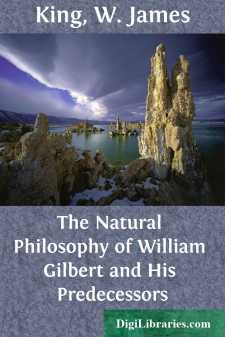Categories
- Antiques & Collectibles 13
- Architecture 36
- Art 48
- Bibles 22
- Biography & Autobiography 813
- Body, Mind & Spirit 142
- Business & Economics 28
- Children's Books 17
- Children's Fiction 14
- Computers 4
- Cooking 94
- Crafts & Hobbies 4
- Drama 346
- Education 46
- Family & Relationships 57
- Fiction 11829
- Games 19
- Gardening 17
- Health & Fitness 34
- History 1377
- House & Home 1
- Humor 147
- Juvenile Fiction 1873
- Juvenile Nonfiction 202
- Language Arts & Disciplines 88
- Law 16
- Literary Collections 686
- Literary Criticism 179
- Mathematics 13
- Medical 41
- Music 40
- Nature 179
- Non-Classifiable 1768
- Performing Arts 7
- Periodicals 1453
- Philosophy 64
- Photography 2
- Poetry 896
- Political Science 203
- Psychology 42
- Reference 154
- Religion 513
- Science 126
- Self-Help 84
- Social Science 81
- Sports & Recreation 34
- Study Aids 3
- Technology & Engineering 59
- Transportation 23
- Travel 463
- True Crime 29
The Natural Philosophy of William Gilbert and His Predecessors
by: W. James King
Categories:
Description:
Excerpt
Until several decades ago, the physical sciences were considered to have had their origins in the 17th century—mechanics beginning with men like Galileo Galilei and magnetism with men like the Elizabethan physician and scientist William Gilbert.
Historians of science, however, have traced many of the 17th century's concepts of mechanics back into the Middle Ages. Here, Gilbert's explanation of the loadstone and its powers is compared with explanations to be found in the Middle Ages and earlier.
From this comparison it appears that Gilbert can best be understood by considering him not so much a herald of the new science as a modifier of the old.
The Author: W. James King is curator of electricity, Museum of History and Technology, in the Smithsonian Institution's United States National Museum.
The year 1600 saw the publication by an English physician, William Gilbert, of a book on the loadstone. Entitled De magnete, it has traditionally been credited with laying a foundation for the modern science of electricity and magnetism. The following essay is an attempt to examine the basis for such a tradition by determining what Gilbert's original contributions to these sciences were, and to make explicit the sense in which he may be considered as being dependent upon earlier work. In this manner a more accurate estimate of his position in the history of science may be made.
Figure 1.—William Gilbert's Book on the Loadstone, Title Page of the First Edition, from a Copy in the Library of Congress.(Photo courtesy of the Library of Congress.)One criterion as to the book's significance in the history of science can be applied almost immediately. A number of historians have pointed to the introduction of numbers and geometry as marking a watershed between the modern and the medieval understanding of nature. Thus A. Koyré considers the Archimedeanization of space as one of the necessary features of the development of modern astronomy and physics. A. N. Whitehead and E. Cassirer have turned to measurement and the quantification of force as marking this transition. However, the obvious absence of such techniques in De magnete makes it difficult to consider Gilbert as a founder of modern electricity and magnetism in this sense.
There is another sense in which it is possible to contend that Gilbert's treatise introduced modern studies in these fields. He has frequently been credited with the introduction of the inductive method based upon stubborn facts, in contrast to the methods and content of medieval Aristotelianism. No science can be based upon faulty observations and certainly much of De magnete was devoted to the destruction of the fantastic tales and occult sympathies of the Romans, the medieval writers, and the Renaissance. However, let us also remember that Gilbert added few novel empirical facts of a fundamental nature to previous observations on the loadstone. Gilbert's experimental work was in large part an expansion of Petrus Peregrinus' De magnete of 1269, and a development of works like Robert Norman's The new attractive, in which the author discussed how one could show experimentally the declination and inclination of a magnetized needle, and like William Borough's Discourse on the variation of the compass or magnetized needle, in which the author suggested the use of magnetic declination and inclination for navigational purposes but felt too little was known about it. That other sea-going nations had been considering using the properties of the magnetic compass to solve their problems of navigation in the same manner can be seen from Simon Stevin's De havenvinding.
Instead of new experimental information, Gilbert's major contribution to natural philosophy was that revealed in the title of his book—a new philosophy of nature, or physiology, as he called it, after the early Greeks....


